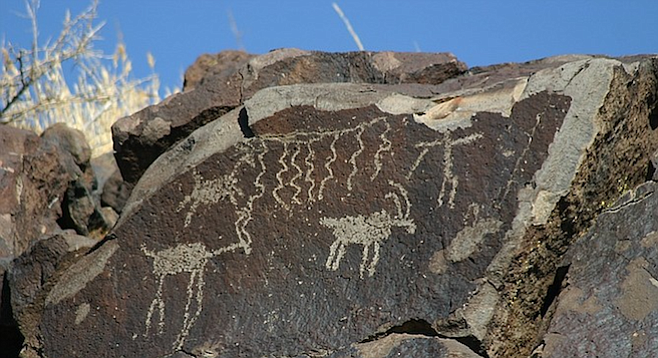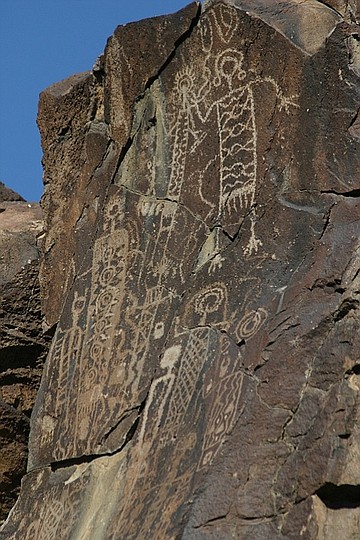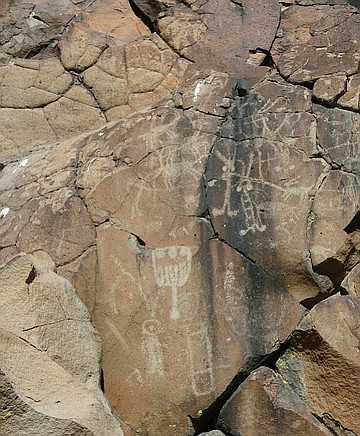 Facebook
Facebook
 X
X
 Instagram
Instagram
 TikTok
TikTok
 Youtube
Youtube

At night, especially under a full moon, the locals say you can hear the voices of the ancient ones. They ride the wind, telling the story of their people as they glide across the rocks.
The Koso Mountain range of Southern California is a place of magic — some would say of power — bisected by a two-mile-long gully lined with massive boulders, and almost every one of them etched with a history of the land and its people. The gully lies at the center of a 90-square-mile area where an estimated 100,000 individual rock art carvings are currently being recorded and catalogued. It's the single largest gathering of petroglyphs in the northern hemisphere.
Perhaps the most fascinating fact is that the entire rock art area lies within the confines of the China Lake Naval Weapons Testing station in the interior desert of California.
Visitors are limited, must pass background checks in advance, and show proper I.D. in order to get a guided tour. You can't just drive in unescorted — and that's the main reason such a vast and priceless part of history is free from vandalism and graffiti. Tours are only offered during spring and fall.
The name China Lake is the result of the influx of Chinese laborers brought in to complete the Transcontinental Railroad in the 19th century. They spread throughout the area after being laid off, many of them working as mule team operators in the interior mountains.

Petroglyphs are images scratched into a rocks surface using a harder stone. Pictographs are images drawn or painted on a stone. In the Koso range, the rocks are mostly basalt with a deep brown patina from the desert sun and wind, that when removed by scratching, reveals the lighter rock face within, forming the artist’s image. These volcanic boulders were belched up from deep inside the earth anywhere from 30,000 to one million years ago by a gigantic, seismic upheaval in an area still active today. They are the canvas upon which the story of the people is told.
The land is named for the Koso people, commonly known as the Shoshone, and they lived there as long as 10,000 years ago; although today there are no living descendants who can verify the meaning of the carvings. This area contains the single most revealing series of ancient images about a particular people anywhere on earth, chronicling a life style now lost forever... except to speculation.
There's much archeological evidence of trade between both the Paiute and the more coastal Chumash peoples and the Shoshone, so some of the more fascinating groupings of figures are perhaps depictions of such meetings.
Similar carvings have been found on the Channel Islands to suggest this interaction. The Chumash routinely traveled between the mainland and the islands offshore in enormous canoes, and one rock clearly shows a man sitting in a boat with a paddle, although it resembles a kayak more than a regular boat. That single image has fueled rumors of northern coastal tribes such as the Inuit and Inupiaq having paddled that far south to trade.
The Koso carvings can, for the most part, be relegated to three main groups: animals, abstract symbols, and anthropomorphic figures. The most ubiquitous are Bighorn Sheep, showing their importance as a food source, but more than a dozen other animals are depicted, many of them non-food sources.
Many carvings portray hunting scenes with men using bows or atlatls and bullroars. Quite a few portray people in lavish costumes and headdresses, most commonly believed to have been shaman conducting ceremonies. They give insight to the physical trappings and decorations so important in early rituals.
There are stylized and geometric figures, some nothing more than squiggles that might be snakes. There are fantastic flying creatures with wings that may represent long extinct insects, and some images so primitive that archeologists suggest some may have been made by children imitating their elders.

More than any other, one single group of figures has been the focus of great speculation. On the side of a massive flat boulder, amid dozens of other renderings, are the clear images of at least three men that some say are wearing helmets, or have an aura about their heads. Those who follow the helmet idea say the lines protruding from the helmets are antenna, while those who cling to the aura idea say the lines are spiritual power being sent out. Either way, this one small carving group has fueled speculation about extra-terrestrials much the same way that the Nazca lines of Peru drove science fiction authors like Robert Temple who claim we were visited eons ago by superior races from afar.
Visitors are often shocked to find a pictograph of Einstein’s theory of relativity, E=mc2, etched into one boulder and surrounded by obviously modern mathematical equations. This is the work of unscrupulous government scientists who were stationed at the base from 1945-54 from the Atomic Energy Commission who apparently wished to leave their mark.
Petroglyphs were man’s earliest form of expression, at least the sturdiest form to have survived, and the carvings of the Koso range are a giant open book filled with history, and culture.
The public can reach the one canyon that holds the largest concentration of Koso rock art, by contacting the NAWS China Lake's Public Affairs Office. You can email [email protected]. You can also contact the Maturango Museum in Ridgecrest. To learn how to arrange a tour, send an email or call the Maturango Museum at (760) 375-6900.


At night, especially under a full moon, the locals say you can hear the voices of the ancient ones. They ride the wind, telling the story of their people as they glide across the rocks.
The Koso Mountain range of Southern California is a place of magic — some would say of power — bisected by a two-mile-long gully lined with massive boulders, and almost every one of them etched with a history of the land and its people. The gully lies at the center of a 90-square-mile area where an estimated 100,000 individual rock art carvings are currently being recorded and catalogued. It's the single largest gathering of petroglyphs in the northern hemisphere.
Perhaps the most fascinating fact is that the entire rock art area lies within the confines of the China Lake Naval Weapons Testing station in the interior desert of California.
Visitors are limited, must pass background checks in advance, and show proper I.D. in order to get a guided tour. You can't just drive in unescorted — and that's the main reason such a vast and priceless part of history is free from vandalism and graffiti. Tours are only offered during spring and fall.
The name China Lake is the result of the influx of Chinese laborers brought in to complete the Transcontinental Railroad in the 19th century. They spread throughout the area after being laid off, many of them working as mule team operators in the interior mountains.

Petroglyphs are images scratched into a rocks surface using a harder stone. Pictographs are images drawn or painted on a stone. In the Koso range, the rocks are mostly basalt with a deep brown patina from the desert sun and wind, that when removed by scratching, reveals the lighter rock face within, forming the artist’s image. These volcanic boulders were belched up from deep inside the earth anywhere from 30,000 to one million years ago by a gigantic, seismic upheaval in an area still active today. They are the canvas upon which the story of the people is told.
The land is named for the Koso people, commonly known as the Shoshone, and they lived there as long as 10,000 years ago; although today there are no living descendants who can verify the meaning of the carvings. This area contains the single most revealing series of ancient images about a particular people anywhere on earth, chronicling a life style now lost forever... except to speculation.
There's much archeological evidence of trade between both the Paiute and the more coastal Chumash peoples and the Shoshone, so some of the more fascinating groupings of figures are perhaps depictions of such meetings.
Similar carvings have been found on the Channel Islands to suggest this interaction. The Chumash routinely traveled between the mainland and the islands offshore in enormous canoes, and one rock clearly shows a man sitting in a boat with a paddle, although it resembles a kayak more than a regular boat. That single image has fueled rumors of northern coastal tribes such as the Inuit and Inupiaq having paddled that far south to trade.
The Koso carvings can, for the most part, be relegated to three main groups: animals, abstract symbols, and anthropomorphic figures. The most ubiquitous are Bighorn Sheep, showing their importance as a food source, but more than a dozen other animals are depicted, many of them non-food sources.
Many carvings portray hunting scenes with men using bows or atlatls and bullroars. Quite a few portray people in lavish costumes and headdresses, most commonly believed to have been shaman conducting ceremonies. They give insight to the physical trappings and decorations so important in early rituals.
There are stylized and geometric figures, some nothing more than squiggles that might be snakes. There are fantastic flying creatures with wings that may represent long extinct insects, and some images so primitive that archeologists suggest some may have been made by children imitating their elders.

More than any other, one single group of figures has been the focus of great speculation. On the side of a massive flat boulder, amid dozens of other renderings, are the clear images of at least three men that some say are wearing helmets, or have an aura about their heads. Those who follow the helmet idea say the lines protruding from the helmets are antenna, while those who cling to the aura idea say the lines are spiritual power being sent out. Either way, this one small carving group has fueled speculation about extra-terrestrials much the same way that the Nazca lines of Peru drove science fiction authors like Robert Temple who claim we were visited eons ago by superior races from afar.
Visitors are often shocked to find a pictograph of Einstein’s theory of relativity, E=mc2, etched into one boulder and surrounded by obviously modern mathematical equations. This is the work of unscrupulous government scientists who were stationed at the base from 1945-54 from the Atomic Energy Commission who apparently wished to leave their mark.
Petroglyphs were man’s earliest form of expression, at least the sturdiest form to have survived, and the carvings of the Koso range are a giant open book filled with history, and culture.
The public can reach the one canyon that holds the largest concentration of Koso rock art, by contacting the NAWS China Lake's Public Affairs Office. You can email [email protected]. You can also contact the Maturango Museum in Ridgecrest. To learn how to arrange a tour, send an email or call the Maturango Museum at (760) 375-6900.
Comments